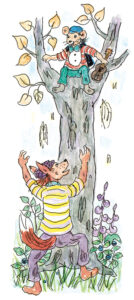
We are pleased to announce that the winner of the NJC Best Article Prize 2022 is Thomas Ugelvik with his article “Three burglars, a friendly police inspector, and a vegetarian fox: Scandinavian exceptionalism, children’s literature, and desistance-conducive cultures”. The article was published in Nordic Journal of Criminology last year.
The prize recognises excellent research and scholarship that engages with current and emerging issues in Nordic criminology.
Congratulations, Thomas! You have just won a prize for a research article published in NJC. In the article you bring up two children’s books to say something about criminology. What is this about and what made you write this particular text?
– Many thanks, I was very pleased to learn that my article had won the NJC best article prize. In a sense, a need to write this article grew in me slowly and over several years as I read these books to my children, again and again, sometimes multiple times in a single day. We’re talking about two absolute classics of Norwegian children’s literature, Claus Climbermouse and the other animals in the Huckybucky Forest and When the Robbers came to Cardamom Town, both written and illustrated by Thorbjørn Egner in the 1950s, and both very much alive and important parts of Norwegian culture to this day.

– Small children like repetition a lot, and after reading a book let’s say more than 20 times, one’s mind starts to wander a bit. And as I sat there reading to them, I started thinking about how both these books are stories of desistance from crime; about how bad people might, if given a second, or third, or fourth chance, change and become valued members of their local communities. In Huckybucky, Marvin Fox starts out as a homicidal highwayman and bully and ends up as a hero after being instrumental in the rescue of little Bruin Bear. In the beginning of Cardamom Town, the three robbers are living parasitically off the inhabitants of Cardamom, stealing what they want with impunity. At the end, after a short stint in prison and a bit of heroism, they are fully integrated members of the village community. And I started to think about what it says about Norwegian society that these two desistance stories are so popular, 60–70 years after their publication. This curiosity led me to write the article.
Runner Up: Janika Lindström & Timo Toikko (2022) Survival stories as access to society. People with history of a crime as experts by experience, Nordic Journal of Criminology, 23:1: 3-22.
Runner Up: Sarah Pritchett & Kim Moeller (2022) Can social bonds and social learning theories help explain radical violent extremism?, Nordic Journal of Criminology, 23:1, 83-101.
